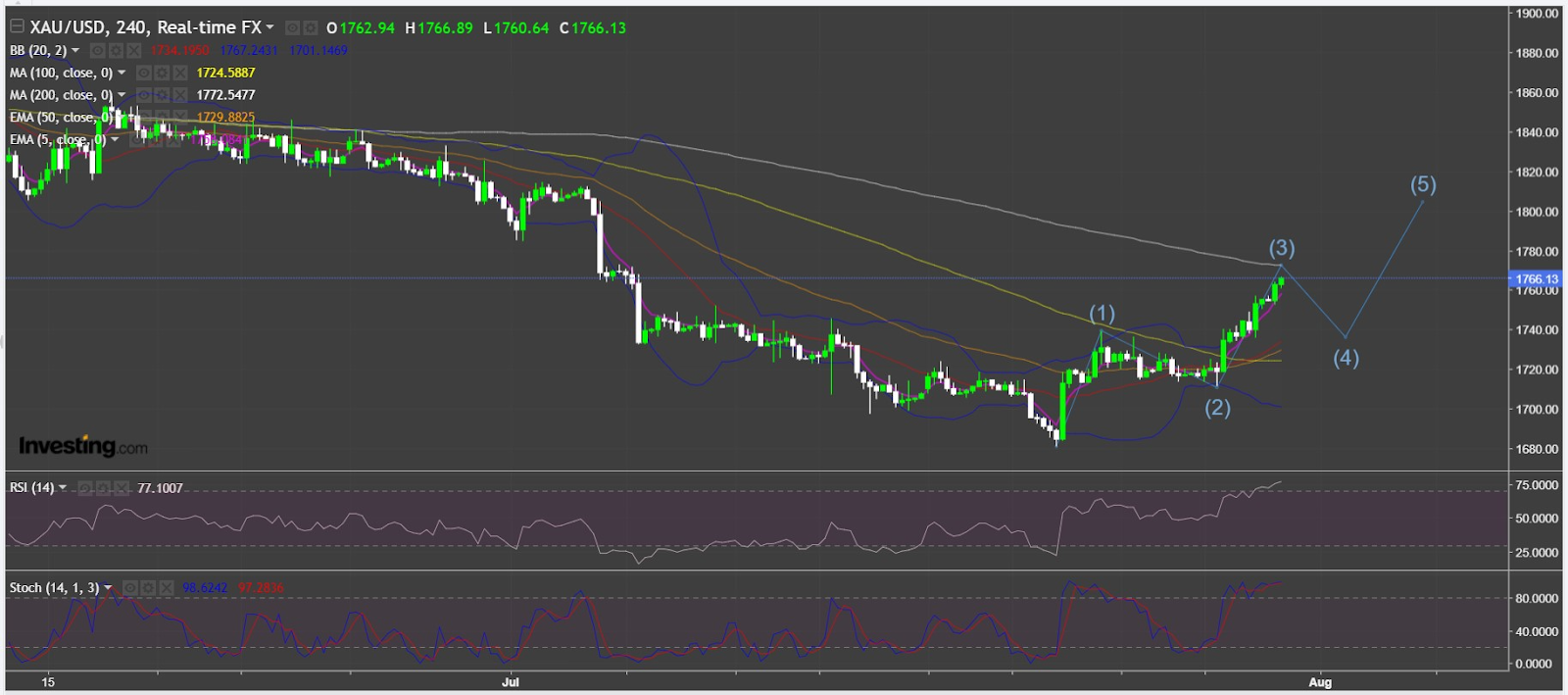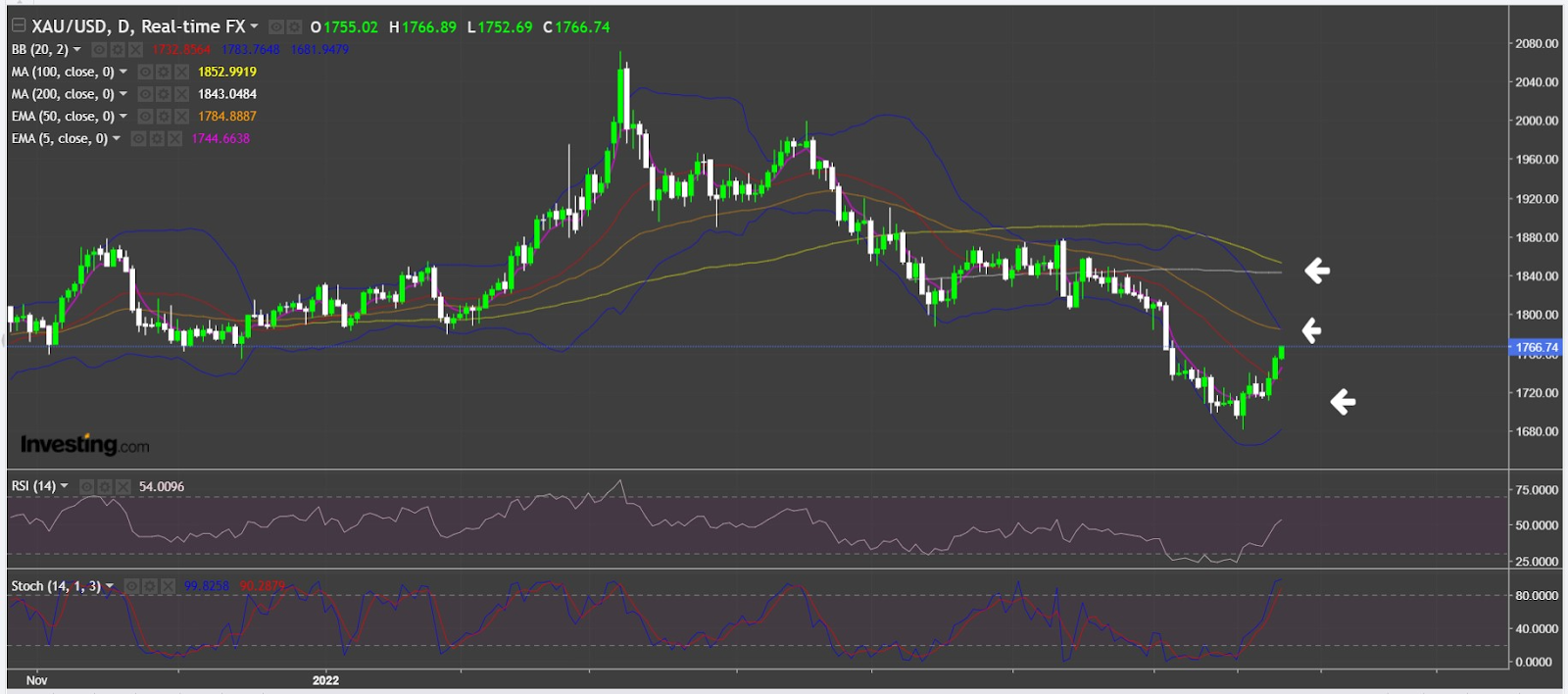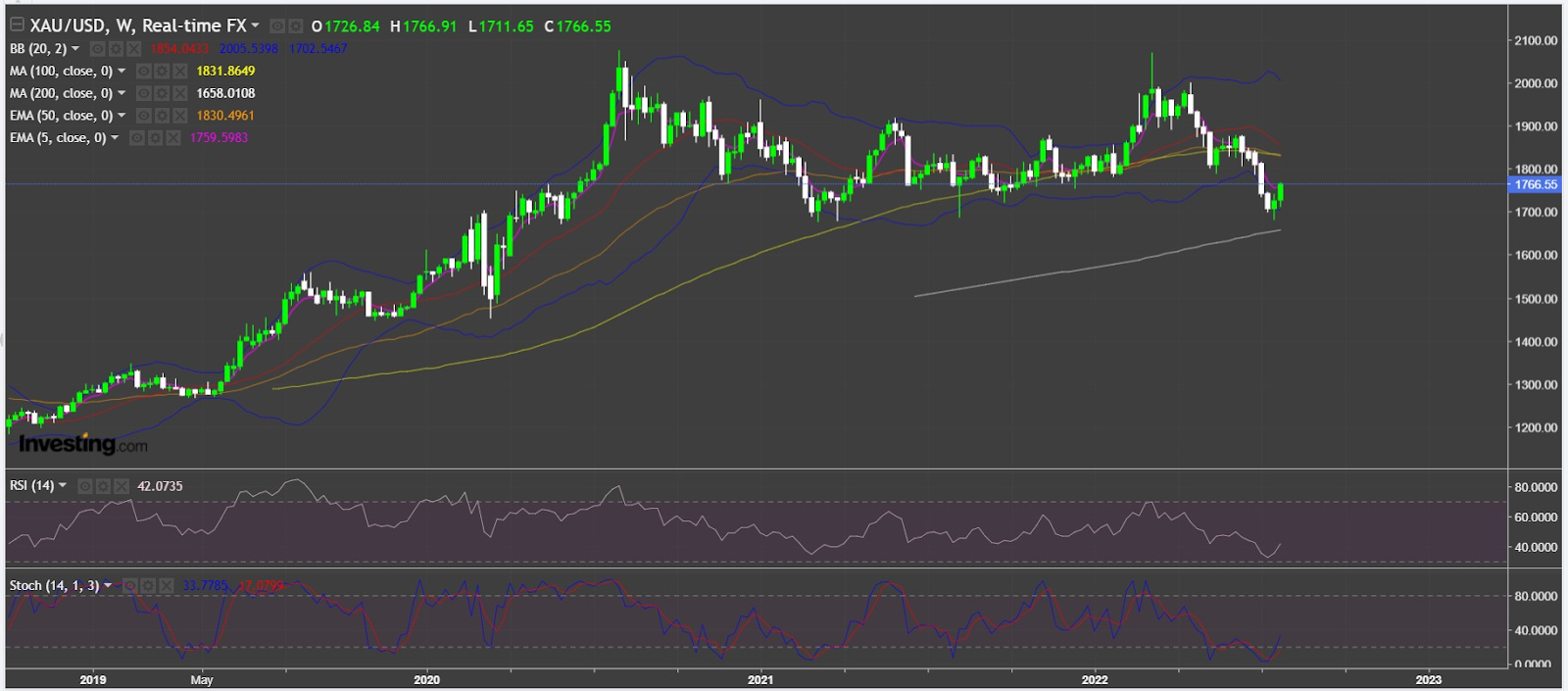S&P 500 falls as ongoing government shutdown, trade jitters weigh
- First US recession since pandemic signals Fed will stop super-sized rate hikes
- Dollar, Treasury yields weaken, opening bullish path for gold
- Chartists say yellow metal must hold above $1,750 in order not to unravel rally
Will the United States’ first re-entry into recession since the coronavirus pandemic—even if that recession is just technical—herald a new dawn for gold bulls?
A recession means different things to different investors.
For the long-oil crowd, it might be time to be less presumptuous about demand, given the strong correlation between the economy and energy usage.
For those on Wall Street, it could be an opportunity to chase up beaten down stock prices, on the reasoning that Federal Reserve rate hikes might be more benign from here.
Likewise, for gold bulls, it is a sign perhaps some serious hedging against inflation will begin now in the yellow metal.
Gold had its biggest one-day rally since March after the Commerce Department reported a 0.9% decline in the first of its three estimates for second quarter US gross domestic product (GDP) growth. The estimate followed a drop of 1.6% established for the first quarter.
The back-to-back quarterly declines in GDP confirmed officially—or at least, technically—months of speculation that the United States was headed for a recession.
It unleashed at once buying that had been pent-up in gold for most of this year, after weeks and weeks of pedestrian moves that sometimes resulted in a daily change of not more than a couple of dollars in both COMEX futures and physical bullion.
Gold is supposed to be a hedge against inflation, but it has not been able to hold up to that billing for most of the past two years since hitting record highs above $2,100 in August 2020. One reason for that has been the rallying dollar Index

Charts by skcharting.com, with data powered by Investing.com
The dollar, a contrarian trade to gold, had a screaming rally over the past year, declining in just three months. For this year, it remains up almost 11%, after a 6% gain in 2021.
But the index, which pits the greenback against six other major currencies, has declined nearly 2% over the past two weeks alone, with the slide accelerating since the Fed on Wednesday opted for a 75 basis point (bps) increase for its fourth rate hike of the year instead of the 100 bps hike anticipated earlier. The smaller increase was a sign that the central bank may have reached a peak in the outsized rate hikes it has been doing to beat inflation raging at 40-year highs.
US bond yields, measured by the benchmark 10-year note, have also retreated in the past three weeks, allowing gold to step up to the fore.
In Thursday’s trade, COMEX gold’s benchmark front-month contract for August delivery settled up $31.20, or 1.8%, at $1,750.30 an ounce, after a session peak at $1,755. That was the largest one-day gain in COMEX gold since March 8, which marked the period of upswing for most commodities in the aftermath of the Ukraine invasion.
Gold’s rally extended in Friday’s Asian trading, with COMEX’s front-month contract reaching a more than three-week high of nearly $1,764 at the time of writing.
Ed Moya, analyst at online trading platform OANDA, said since the start of 2022, gold’s biggest risk had been a robust economy and a Fed that might need to be more aggressive with rate hikes.
Moya said gold could likely face strong resistance at around the $1,800 level. But till then, the next $50 upswing could be relatively easy. He added:
“The risk of a full-percentage rate hike by the Fed is long gone. Gold is breaking out now that a peak in Treasury yields is firmly in place. Stagflation is here to stay and that should be good news for gold prices. The US economy is heading towards a recession and as long as Wall Street believes the Fed will deliver a slower pace of tightening, gold should start seeing safe-haven flows again.”

Christopher Vecchio, a precious metals strategist who blogs on Daily FX, appeared to hold a similar view, saying:
“Forward looking measures of inflation suggest that peak inflation is in the rear-view mirror, and the 2Q’22 US GDP report indicated that the economy is slowing (recession or not, there’s no reason to quibble over the technical definition). These facts beget a relatively more dovish Fed moving forward, whereby even if there are more rate hikes, they’re unlikely to be at the same 75-bps pace we’ve seen over the past two meetings.”
Vecchio described these as “monumental developments” for gold that could translate into a weaker dollar or at least one that’s less likely to continue its meteoric rise moving forward.
“But primarily, these developments mean that US real yields are likely to fall back in the near-term. If rising US real yields underpinned the rationale for weaker gold prices coming into 3Q’22, then falling US real yields means that it’s time to look in the other direction for gold prices—and throw away the 3Q’22 gold price forecast in the process now that the August 2021 near $1,680 was achieved.”
So, what really is the immediate outlook for gold prices then?
Like Moya, Vecchio does not anticipate gold having problems returning to $1,800 in the coming sessions.
“A double top remains in place, but a quadruple bottom around $1,680 warrants a reconsideration: a massive sideways range between $1,680 and $2,075 may have formed. A bounce from $1,680 sees $1,800 as the first area before resistance is found.”

Sunil Kumar Dixit, chief technical strategist at skcharting.com, said holding above $1,750 is critical, failing which gold could drop to between $1745 and $1,735.
Breaking it down, Dixit, who uses the spot price of bullion for his technicals, says two four-hour charts held the key to gold’s advance.
The first was the regular four-hour chart that showed gold approaching wave 3 of the impulsive 1-2-3-4-5 wave pattern coinciding with the 200-Simple Moving Average of $1,772 on the four-hour chart.
The second was an intraday four-Hour chart indicating the Relative Strength Index at 77 and stochastics at 97/96 that will cause an intraday consolidation towards $1,745 support. Dixit adds:
“Some profit-booking may be due from overbought stochastics and an overstretched RSI that could see gold coming down towards the $1745-1735 level for it to gain energy and relaunch towards its next target, which is the 50-Day Exponential Moving Average of $1785.”
“The daily chart’s RSI at 53 is in the above-neutrality area, while stochastics at 96/89 have further potential for an upside move towards the 50-Day EMA of $1,785.”
Disclaimer: Barani Krishnan uses a range of views outside his own to bring diversity to his analysis of any market. For neutrality, he sometimes presents contrarian views and market variables. He does not hold positions in the commodities and securities he writes about.
